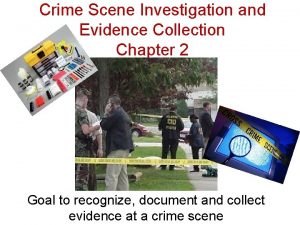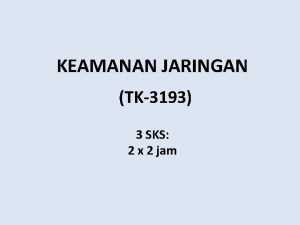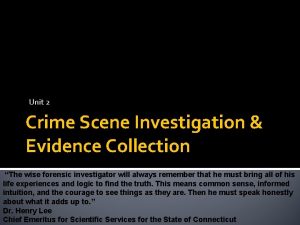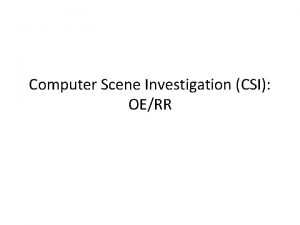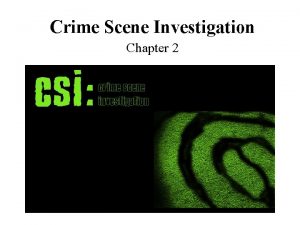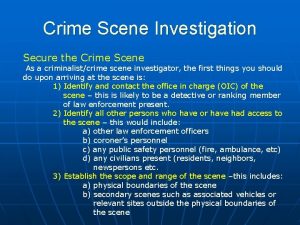Computer Scene Investigation CSI Adverse Reactions Crime Scene












- Slides: 12

Computer Scene Investigation (CSI): Adverse Reactions

Crime Scene: I can’t verify my allergies! A user calls stating they just entered a new allergy, but they can’t “verify” it! Why does the system not trust them?

RPMS side: PATIENT: DEMO, PATIENT ANN CAUSATIVE AGENT: PENICILLIN INGREDIENTS: PENICILLIN VA DRUG CLASSES: ORIGINATOR: NIESEN, MARY ANN ORIGINATED: FEB 11, 2010@10: 45 SIGN OFF: YES OBS/HIST: HISTORICAL ID BAND MARKED: CHART MARKED: SIGNS/SYMPTOMS: ANAPHYLAXIS MECHANISM: ALLERGY Is the reaction information correct? Yes// (Yes) no verify option! Enter another Causative Agent? YES//

Verifying adverse reactions • Solution: – Remember that in this case “verify” mostly means “from a technical standpoint” to ensure the information needed for drug checks/order checks functions as intended. – A user who will be verifying allergy information in this technical sense will require the GMRAALLERGY VERIFY key. – Verification in EHR not recommended as the required fields cannot be seen here.

Crime Scene: I don’t know what allergies have been verified! The user contacts you stating they are sure the allergies have not been kept up to date—but how are they supposed to know who has allergies that need to be verified? Do they have to look at every patient’s profile? !

Finding Unverified Adverse Reactions • Solution: – The Adverse Reaction Tracking package has useful processes and reports for this: • If the user has the verify key, they have access to the menu option to verify allergies. – Allergies can be verified for a single patient or for all patients – Verification can be for drug, non-drug, or both – Adverse Reaction Tracking Verifier Menu Verify Patient Reaction Data • This is not a printable report, per se, but a way to actually verify the allergies. – Can capture with session logging to print, or use the reports available (see next slide)

Finding Unverified Allergies, cont. • Additionally, can use printed reports to find reactions in various states: – From Adverse Reaction Tracking Verifier Menu Reports • Patient Allergies Not Signed Off – If they are not “signed” they cannot be verified • List Autoverified Reaction Data – Users are often surprised by what is autoverified depending on the package settings • List by Location Not Verified Reactions – Listed by “ward” but includes a “ward” called “outpatient” – User does not choose the wards, report will list all – Can also be found in the reports section of the P&T menu of Adverse Reaction Tracking

Crime Scene Allergy Order check not working! A provider calls frantic because the allergy order check did not trigger: the allergy was clearly marked in the problem list as “penicillin” but when ordering “amoxicillin” there was no warning the patient had a drug allergy!

Adverse Reactions and Order Checks • Solution: – Order checks cannot utilize the Problem List • Adverse reactions MUST be entered into the Adverse Reaction Tracking package to be used for Order Checks • The “PLAL” reports can be used to find adverse reactions on the problem lists. • The adverse reactions can then be added to the Adverse Reaction Tracking package • Most sites then remove the adverse reactions from the problem list

Adverse Reactions and Order Checks, cont. • HOWEVER, there are some scenarios where even entries in the Adverse Reaction Tracking package will not trigger order checks, and ALL users should be aware of this: – The patient reaction data is missing ingredients, a VA Drug Class code, or both – The affected drug in the drug file is not matched to NDF, is missing a VA Drug Class code, or both – The provider enters the adverse reaction, then orders a drug, and signs both together

Crime Scene I did all that and *still* don’t get an allergy order check warning! The provider calls back and states they did enter the adverse reaction the “correct” way, signed it immediately, but still was able to order the offending agent without a warning popping up. What gives?

• Although everyone gets sick of hearing it, these questions come up often. – Users should be cautioned against entering “too much” when searching for a causative agent • A simple misspelling can result in a “free text’ entry that is missing the required information – EVERY division must be added to the ART package site parameters – The Drug file must be matched to the National Drug File wherever possible • Drugs that cannot be matched should be manually classed – Patient reactions should have a VA Drug class and/or ingredients added if not already present
 While the csi team is searching the crime scene, _____.
While the csi team is searching the crime scene, _____. Csi computer crime and security survey
Csi computer crime and security survey Seven s's of crime scene investigation
Seven s's of crime scene investigation Crime scene investigation 2106 tcole course
Crime scene investigation 2106 tcole course Tcole 2106
Tcole 2106 Semen collection bags
Semen collection bags The term encompasses all objects that can establish
The term encompasses all objects that can establish Tcole 2106
Tcole 2106 Corpus delicti
Corpus delicti Crime scene investigation background
Crime scene investigation background Small amounts of trace evidence can be conveniently
Small amounts of trace evidence can be conveniently The seven s's of crime scene investigation
The seven s's of crime scene investigation Subdatum points
Subdatum points
